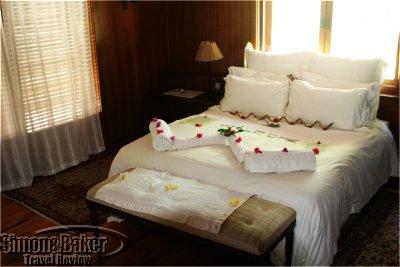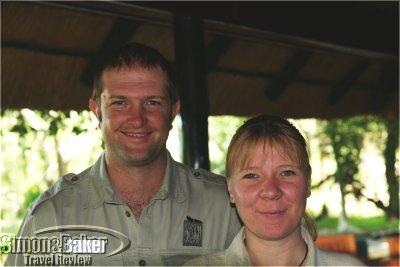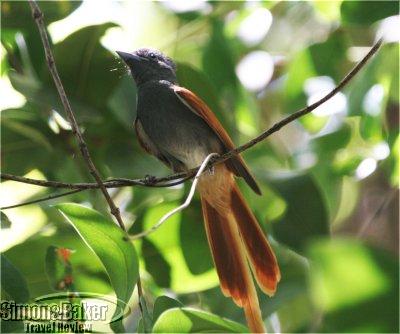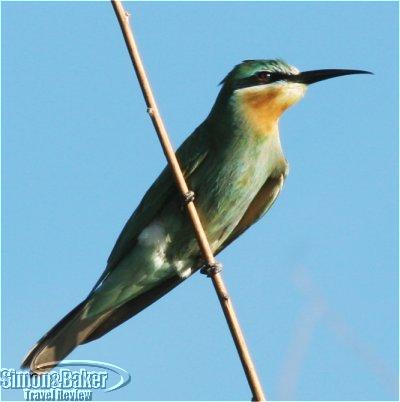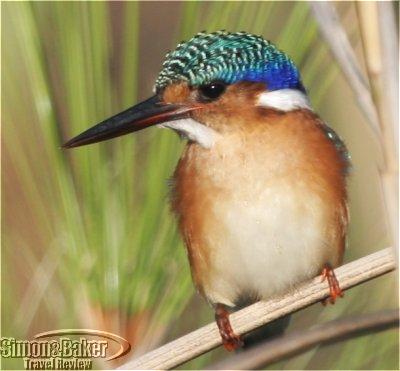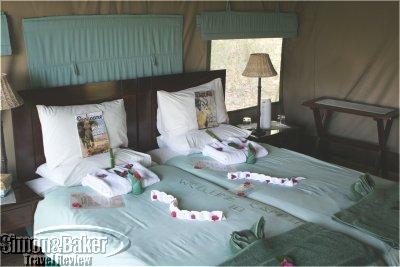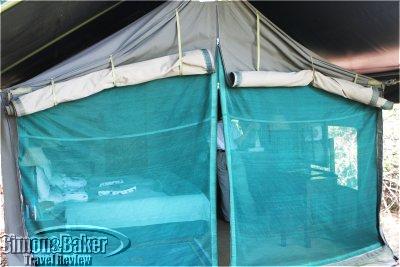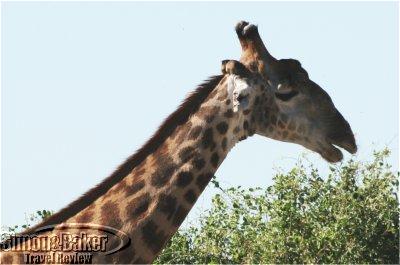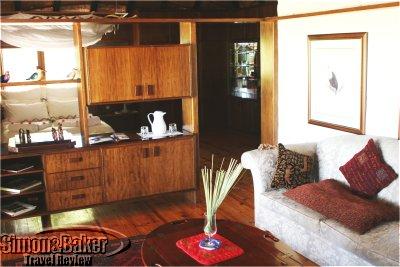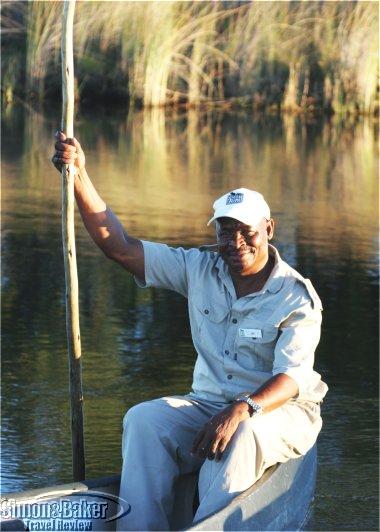
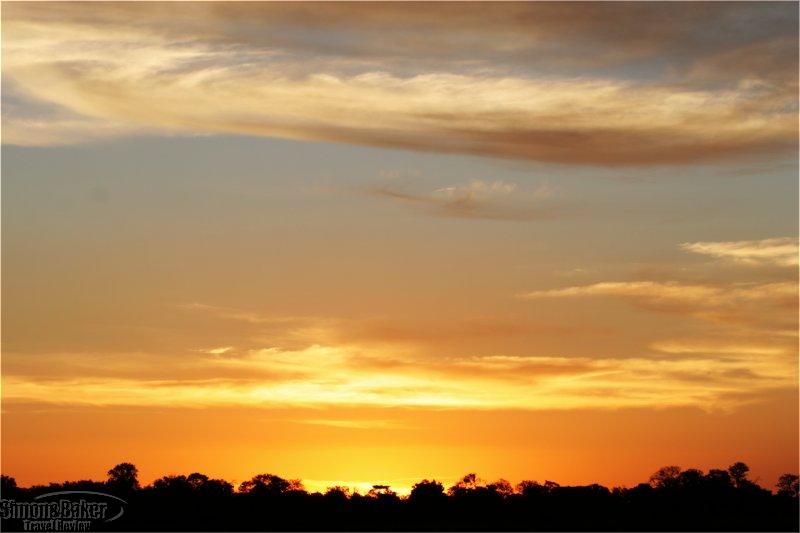

- Overall Impression
- Details
- Common Areas
- Accomodate
- Rooms
- Dining
- Features
- Wildlife
- Activities
- Other
- Review
Camp Okavango was a wonderful place to relax had we chosen to give up an activity and just sleep in or spend the afternoon luxuriating with a book on the hammock or on a lounge chair by the plunge pool. Animal sounds, especially birdsong, were everywhere and there were plenty of activities to keep us busy. Our first afternoon we went for a motorboat ride among the papyrus and common reeds of the Okavango Delta; the following morning we went for a four hour walk on a nearby island. In the afternoon we went for a fabulous mokoro (type of canoe) ride. We lingered over the sunset colored with rich shades of orange and maroon. Minutes later, we were transported by the full moon rise set against a mauve and pale yellow sky of the Delta. That late afternoon and dusk ride we experienced the magical beauty and serenity of the Okavango Delta that so many before us have described.
We valued the Camp’s atmosphere focused on “birding, peace and tranquility,” the efficient and smiling staff, the option to relax or participate in bird watching and some game viewing on foot or by boat, the close-to-nature yet comfortable tents with teak floors and en suite bathrooms and the luxurious honeymoon suite built to the strict specifications of Jesie Neal, the American woman who established the Camp in 1980. We especially enjoyed table and fireside chats with fellow international guests and spending time and learning from “John” Odumetsi, our guide who grew up and lived most of his life in the area before it was developed into a tourism destination. His upbeat, positive can-do style and passion for the Delta led us discover its many treasures and appreciate what life was like in the not too distant past when it was necessary to travel 14 days by mokoro to reach the nearest town.
Handicapped Access Although the conditions were not ideal, the Camp had hosted handicapped guests in the past. Enquire directly with the camp for layout and other relevant details.
Length Of Stay Two nights
Location In the central Delta on Naxargara Island, about 30 minutes by bush plane from Maun .
Managed Desert & Delta Safaris, a 100 percent subsidiary of Chobe Holdings Ltd.
Managers Rob Van Tonder and Tammy Cronk who took charge of Camp Okavango in February of 2005 shared management duties. Rob looked after guides, activities, maintenance and the grounds while Tammy’s responsibilities included food services, guest relations, housekeeping and finances.
Owned Chobe Holdings Limited owns the leases on the Camp. The current lease expires in 2012 with the option to renew through the tender process. Chobe Holdings Limited, a long established, Botswana public company listed on the Botswana Stock Exchange, owned and operated six luxury safari lodges including this one. All of the lodges were in locations within the northern National Parks and the Okavango Delta. Desert & Delta Safaris also owned a fleet of eight light aircraft, which enabled convenient booking (though bumpy flights) for guests to each lodge with regular connections to Livingstone, Victoria Falls and Maun.
Size The Camp, situated on a three square kilometer island, occupied about one third of the island. It could house 24 guests in 11 tents and one honeymoon suite with a staff of 28 and 3 managers. The leased area is five hectares in size.
Year Opened-Recent Renovation The first building, now the honeymoon suite, was erected in 1980. The Camp opened in 1998. Renovations were ongoing.
In the suite, wooden steps led down to the sunken black and white tile bathroom. The walls were of black ceramic tile. There was also a black sink and black toilet bowl. White floors and a mirrored and well lit ceiling softened the look. A claw foot bathtub drew our attention (the water looked brown when we filled the tub to remind us we were in Africa after all) and across from it an there was an enclosed shower stall. A screened window looked out onto a private enclosed area.
The 75-square meter thatched roof honeymoon suite was designed to be the home in Africa of a wealthy American woman who first decided to live on the island 25 years before our visit. It was remarkable to think of the time and effort required to build it, especially since almost everything had to be brought by boat (as of this writing trucks cannot reach this part of the Delta). Three steps led to the broad glass door entrance. Inside, there was wood everywhere. Teak floors and yellow stink wood and teak furniture set the backdrop of the room. With the exception of a white wall in the living area, nearly every other wall was of, or covered with, wood. Mirrored tiles accented and brightened the back wall of the bedroom and a small wall behind the dining area.
There was a living area with a gray cloth sofa, a gray patterned armchair and matching large foot stool and a wood coffee table. There were three handsome bird themed watercolors (fish eagle, a giant eagle owl and secretary bird) by S. Santilhano from 1994 and 1995 in the living and dining areas of the suite. To the right on the living area, there was a small dining table and wet bar. To the left, a wide partly open shelf separated the bedroom from the rest of the suite. A double bed, nostalgic looking with the mosquito net at night, occupied the center of the bedroom. A night table and lamp stood to either side of the bed. A small stool rested at the foot of the bed and a green cloth armchair was in a corner. There were oriental style throw rugs in the living area and on either side of the bed. Two slow moving fans gave the room a tropical feel. Although it was very warm in the early evening and darker than we would have liked (we shut the wood shutters to keep the insects out), overall we found the room spacious and comfortable, a wonderful place to spend time between activities and to relax.
Facilities There was an open area with comfy armchairs near the mangoosteen tree, bar, fireside open area or boma , dining room, dock area, plunge pool and treetop hide which was one of our favorite places in the Camp along with the mangoosteen tree.
Pool There was a 6-square meter (3 x 2) large and 1.5 meter deep plunge pool in the garden. Three wood armchairs, four lounge chairs, one umbrella and ample tree shade invited us to linger every time we walked by.
We also saw: kudu, red lechwe, elephant, hippopotamus, bush squirrel, wart hog, vervet monkeys, Nile crocodiles, and reed frog. Birds: blackcollared barbet, bluecheeked, carmine and whitefronted bee-eaters, redeyed bulbul, blackbacked cisticola, reed cormorant, darter, redeyed dove, bateleur eagle, paradise flycatchers, redbilled francolin, helmeted guineafowl, purple heron, redbilled woodhoopoe, African jacana, malachite, pied and woodland kingfishers, black korhaan, grey lourie, Angola pita, blacksmith plover, secretary bird, longtailed shrike, greyheaded sparrow, and redshouldered widow.
Other The Camp ran on generators. This meant at night when the generators were switched off, the only light in our tent and suite came from battery operated bedside lamps.
Cleanliness Excellent
Date Of Last Visit November 2005
Reviewers © 2006 Simon and Baker, Inc.
Article by Elena del Valle
Photographs by Gary Cox
Service There was twice daily room service. Staff, some of whom had limited English skills, were pleasant and knowledgeable.
Would You Stay Again? Yes
Contact Information
- Desert & Delta Safaris
- Private Bag 310 Maun
- Botswana
- +267 686 1243
- +267 686 1791
- Desert & Delta Safari Lodges
- Reservations and marketing
- P.O. Box 13055
- Bryanston, 2074
- +27 11 706 0861/2
- 463 2996
- +27 11 706 0863
- 086 654 5155
